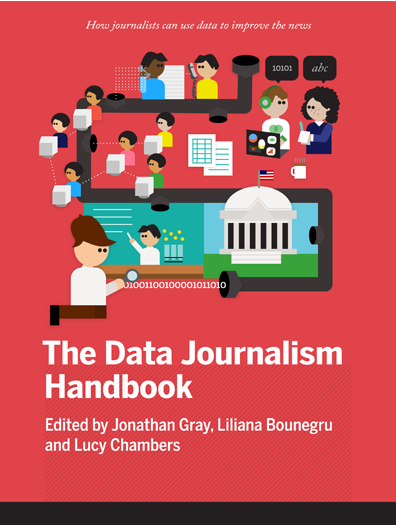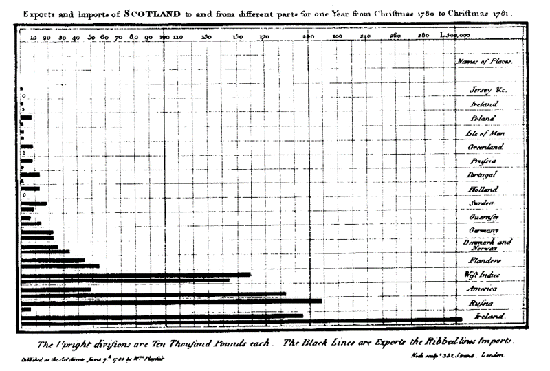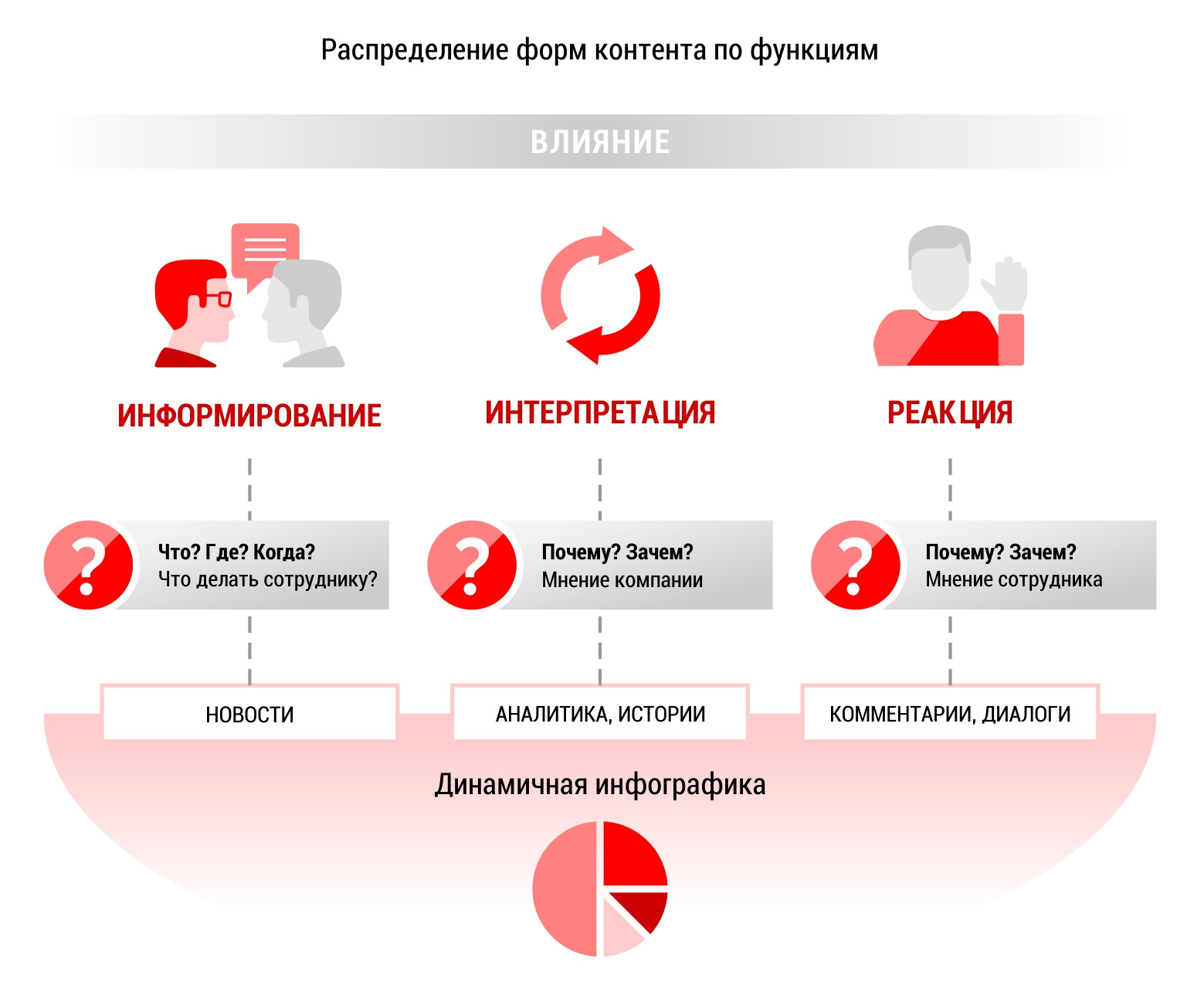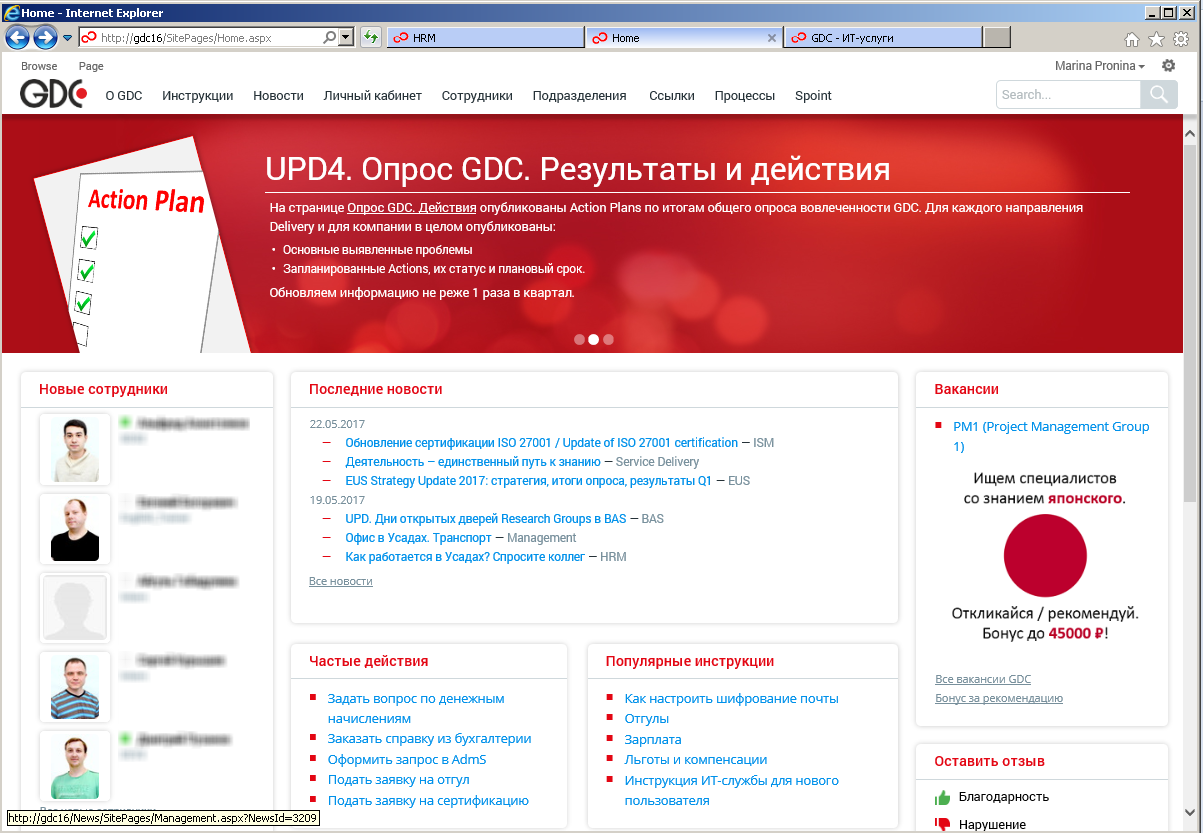Corporate Information: Reality and Fantasies
I've been thinking a lot about data journalism lately. Why do companies lazily adapt interactive infographic features to their needs? And will these great information services be so great for employees? Fantasies on the topic pulled an analysis of reality, so the first half of the text about what is informing and what to do with it.

Despite the general progress, in a considerable number of companies the intranet still exists for show. He does not have an owner involved, because in the IT departments (where he usually relates) there are no specialists who professionally work with information and content. Those same philologists, PR specialists, translators. And since the mainstream media dangles ownerlessly, we can safely say that the information function in the company is not framed.
We agree on the terms. Informing, and I'm talking about mass information, is the timely delivery of news information to employees (what, where, when). Information is an important management tool, because many business processes can be blocked if the employee does not know and does not do something in time.
Yes, at first glance it seems that everything is clear and simple. But in fact, while the company is small, important information comes from all corners of the office, and when it is already 300+, the information disappears or its distribution becomes chaotic. It is possible to leave this topic unattended for some time, but it is already fraught.
Example
In the concept of “informing” there are two key characteristics. The first is one-sidedness: they say, we said, and there you somehow read it and think it over yourself. The second is objectivity: we do not select texts to formulate your opinion anyway, we are classic news journalism. That is, we bring information to the masses when the reason for publication is undeniable: the event will happen or happened.
Recently, however, they began to look at information a little dismissively. Like, this is about one-sidedness, monologicity, non-strategicity and generally not the business of communications specialists. Maybe. But at the same time, one must not forget that informing, quality informing is precisely what the communicator needs to build in the company in the first place. And only then to complete tasks and ways to solve them.
What one can do with one-sidedness is understandable. These are social network games and functionality: likes, dislikes, comments, polls, etc.
Example
As for influence, here the issue of goal-setting is acute. While the system is operating in the informing mode, only tactical tasks are solved, which are able to formulate the average management. If we go into the classical influence, then leadership should be included. It should assess the situation, taking into account all the analytics on staff satisfaction, all visions and its own business plans - and formulate a goal: why will we influence, on whom, for how long.
And here we are not talking about propaganda in its modern political "sense", although, of course, any influence is about the interpretation of chaos. And this is a natural human need and typical social expectations. The audience of the company, like any other audience, needs to reduce uncertainty and expects this from the company. You can generate negativity, you can ignore it, or you can explain it. And ideally - mark the material with an understandable marker, so that the employee understands where the news is, and where "for life."
Example
Reflecting on the resource intensity of the content plan, I began to read about data journalism. In 2014, RIA had a wonderful translation of The Data Journalism Handbook , which vividly and with examples describes this content phenomenon. And it seemed to me that using the data journalism approach could well lie on the tasks of corporate communication.

Blogging, storytelling, podcasts, streams - this is a story about author’s content, that is, a description of the phenomena is always through the prism of the author’s “I”. Therefore, there will always be additional work by the authors. In such communication, a traditional set of roles is preserved: “writer - reader”, and these are different faces.
What does data journalism offer? In general, she also offers author's reports and investigations, but after the stage of collecting a large amount of data, its analysis and visualizations. But these traditional authoring add-ons are optional. By themselves, these visualizations become finished material. As if informing. After all, some objective data is published. But in reality, everything does not end with classic information. Such content is both dialogue and interpretation.

Such a histogram was presented by William Playfair in 1786 (!) In order to visually show the quantitative indicators of imports to Scotland.
Each reader, looking at these data, becomes an author himself. That is, he himself comes up with a plot based on a point of view relevant to himself, isolates from the proposed data and connections that are of interest to him. The deeper the data and the more sophisticated visualization, the reader = author can create full-fledged materials that can be interviewed and published if desired. And here is a new version of “readers' letters” to the editor (content content content), but optional, because communication has already happened.
Thus, we inform the reader, but inform: a) online; b) without thematic aggression; d) involving in dialogue and interpretation. Yes, creating such services is time consuming. But this is a project, not a process: creating it once, we give the world content without an expiration date.
Example
Well cool!?!
And now a fantasy on corporate data visualizations. PR specialists, designers and programmers gather and make a chic volumetric deep interactive infographic. What topic? On all key. Finance, customers, social, expenses, income. It is worth asking colleagues what information they lack. You can look at the sore topics. For example, if employees do not see the connection of their work with the general goals of the company, then output data that will answer this question. "I brought the company so much money, the company spent so much on me." With all taxes in both directions, with all investments. You can build in some feats of surname. It can be detailed on teams, on departments - it depends on the company's culture in relation to personal merits.
As a rule, these data are in various forms in companies and serve the tasks of management accounting. Someone has beautiful excels with complex formulas, someone has chaotic, not yet combined notebooks. And it is clear that before such data is published, you need to configure their collection. Well, be prepared for errors, incorrectness and investigations of employees. But what? .. Auditors have less work, optimization from the “bottom”, we encourage initiatives.
And yes, they are throwing tomatoes at me now, saying that no leader would agree to openly issue such data. I will not argue with that. It seems to me that it can. Any adult understands that one of the objectives of the corporation is the profit of shareholders, so this information can be perceived quite loyally. Especially if, at the same time, the manager offers employees comfortable jobs, and employees have a choice. In addition, the form of dashboards is already firmly included in the reporting of any levels. You just need to strengthen it with interactivity, publicity and multi-level connections that are understandable to a wide audience (!). After all, the second risk here is the employee himself, who does not want or is not able to work with information. Therefore, communication should be eternal and visual, and the audience loyal to the skill of analysis.

Example
Why all this? And the fact that informing is wonderful. Informing with a static fact is the basis, influencing the content plan and analytics is powerful, and informing and interpreting with interactive communications is a possible development (not only the communication functions, but also all the target audience). Even if at first glance this option seems very idealistic. I would love to take on such a project. Well, or would dream with someone else on this subject :)

Set up base
Despite the general progress, in a considerable number of companies the intranet still exists for show. He does not have an owner involved, because in the IT departments (where he usually relates) there are no specialists who professionally work with information and content. Those same philologists, PR specialists, translators. And since the mainstream media dangles ownerlessly, we can safely say that the information function in the company is not framed.
We agree on the terms. Informing, and I'm talking about mass information, is the timely delivery of news information to employees (what, where, when). Information is an important management tool, because many business processes can be blocked if the employee does not know and does not do something in time.
Yes, at first glance it seems that everything is clear and simple. But in fact, while the company is small, important information comes from all corners of the office, and when it is already 300+, the information disappears or its distribution becomes chaotic. It is possible to leave this topic unattended for some time, but it is already fraught.
Example
When I came to the company, there were just 400 of us, the intranet was represented by two "dead" portals, HR was responsible for one, and the second was technically supported by IT. The main way the information was delivered was through corporate mailing. And what were these mailings! They sent everything in a row: from key data on bonuses to announcements about the loss of keys somewhere out there. Each letter was surprising with its html-layout, although the authors tried to copy the template from the previous letter. They answered letters and often immediately to the whole company. It is clear that the presentation style and grammar were also copyrighted. There was no news feed.
What could employees do in such a situation? Of course, remember spam, set up mailings in a separate box and never look there. Although this was difficult to do, as letters could come from personal addresses. As a result, it was difficult to call such an “uncleaned" channel official. And this is a normal stage in the development of the company, the main thing is to pay attention to the function and to engage in improving manageability here too.
Then an initiative group came together and it took us about three quarters to combine the portals, think over the info architecture, fill in the basic content, come up with business logic for newsletters and implement it on SharePoint, distribute rights, select content managers in the “fields” of the departments. With regard to informing, the principal was done:
- Limited access to the newsletter;
- The newsletter was made only on important and urgent occasions, the rest went into the news and the weekly digest;
- Highlighted editor-moderator;
- The mailing template has become as hard as possible;
- Authors have been trained.
That was in 2013. Almost five years ago. During this time, nothing has changed: neither the digest design, nor the “marker” for key news, to the newsletter template. On the one hand, it is a stone in my "maternity" garden. And on the other: what works well doesn’t really need to be touched. Awareness channel is configured. The generation of employees remembering the old portals has long been blurred by the new 800+. And the universal Zen rule is very useful here: 30% do not read the news, 30% read from time to time, 30% always read, 10% write news. Is always. Regardless of the frequency of redesigns.
This is the main page of the corporate portal ICL Services
Information, dialogue, influence
In the concept of “informing” there are two key characteristics. The first is one-sidedness: they say, we said, and there you somehow read it and think it over yourself. The second is objectivity: we do not select texts to formulate your opinion anyway, we are classic news journalism. That is, we bring information to the masses when the reason for publication is undeniable: the event will happen or happened.
Recently, however, they began to look at information a little dismissively. Like, this is about one-sidedness, monologicity, non-strategicity and generally not the business of communications specialists. Maybe. But at the same time, one must not forget that informing, quality informing is precisely what the communicator needs to build in the company in the first place. And only then to complete tasks and ways to solve them.
What one can do with one-sidedness is understandable. These are social network games and functionality: likes, dislikes, comments, polls, etc.
Example
We still haven't turned on the news comment feature. Mostly because of our perfectionism, since we assume that there will be a significant amount of content that we need to work thoughtfully with. Although one colleague told me with confidence that no one will respond to each other's comments better than the employees themselves. Maybe ... But another solution comes to mind. The company has had a collective blog for many years (longer than a full-fledged portal) that is not connected with the official base of employees, which is currently going through hard times. But can we combine it with the official news feed so as not to compete with the already familiar resource and numerous external social networks? Just at the level of posting important news and digest? You look, and the number of registered participants will increase,
As for influence, here the issue of goal-setting is acute. While the system is operating in the informing mode, only tactical tasks are solved, which are able to formulate the average management. If we go into the classical influence, then leadership should be included. It should assess the situation, taking into account all the analytics on staff satisfaction, all visions and its own business plans - and formulate a goal: why will we influence, on whom, for how long.
And here we are not talking about propaganda in its modern political "sense", although, of course, any influence is about the interpretation of chaos. And this is a natural human need and typical social expectations. The audience of the company, like any other audience, needs to reduce uncertainty and expects this from the company. You can generate negativity, you can ignore it, or you can explain it. And ideally - mark the material with an understandable marker, so that the employee understands where the news is, and where "for life."
Example
The basic tool in the formation of a managed information field is a content plan. He is well known to marketers and PR managers. And if internal communications are integrated with external ones, then questions about its use will not arise. In our case, VCs are part of HR, and here historically different methods and approaches. Recently, we began to plan the placement of materials not only for obvious news reasons, but also analytics, reports, opinions, stories about people. Before that, there were similar materials, but, as a rule, in the form of “letters to the editor” or as an answer to something that was already too “burning”. In order for employees to value their health and VHI, you need to remind them of this on a quarterly basis, revealing the topic from different angles. And more than once a year at the time of issuing new policies ... Unfortunately, this development branch involves a significant increase in the volume of work, inclusion of a large number of people in the tasks of generating content and all this on an ongoing basis. Can a non-core business afford the staff of not only a professional editor, but also a journalist?
Data Journalism: Reader = Author
Reflecting on the resource intensity of the content plan, I began to read about data journalism. In 2014, RIA had a wonderful translation of The Data Journalism Handbook , which vividly and with examples describes this content phenomenon. And it seemed to me that using the data journalism approach could well lie on the tasks of corporate communication.

Blogging, storytelling, podcasts, streams - this is a story about author’s content, that is, a description of the phenomena is always through the prism of the author’s “I”. Therefore, there will always be additional work by the authors. In such communication, a traditional set of roles is preserved: “writer - reader”, and these are different faces.
What does data journalism offer? In general, she also offers author's reports and investigations, but after the stage of collecting a large amount of data, its analysis and visualizations. But these traditional authoring add-ons are optional. By themselves, these visualizations become finished material. As if informing. After all, some objective data is published. But in reality, everything does not end with classic information. Such content is both dialogue and interpretation.

Such a histogram was presented by William Playfair in 1786 (!) In order to visually show the quantitative indicators of imports to Scotland.
Each reader, looking at these data, becomes an author himself. That is, he himself comes up with a plot based on a point of view relevant to himself, isolates from the proposed data and connections that are of interest to him. The deeper the data and the more sophisticated visualization, the reader = author can create full-fledged materials that can be interviewed and published if desired. And here is a new version of “readers' letters” to the editor (content content content), but optional, because communication has already happened.
Thus, we inform the reader, but inform: a) online; b) without thematic aggression; d) involving in dialogue and interpretation. Yes, creating such services is time consuming. But this is a project, not a process: creating it once, we give the world content without an expiration date.
Example
A team of journalists, designers and programmers gathered and decided that this month they are collecting data on the quality of schools in the city of O, since residents do not have transparency, and they are lost in choice, and complaints are received by the editorial office (social request as an excuse). After that, data on the topic is collected, mapped, reduced, cleaned, supplemented by fresh editorial “excavations” and finally published on the editorial website as an interactive service. Anyone can use the service: find their school, compare with schools in the area, see the highest ratings in the city, see the lowest, compare schools on the basis of X, make correlations on the basis of X and Y ... Yes, journalists will make their stories here and, more likely all, they will embed this content in some adapted form into this visualization. But each user will also draw their own conclusions,
Well cool!?!
Big Infographics
And now a fantasy on corporate data visualizations. PR specialists, designers and programmers gather and make a chic volumetric deep interactive infographic. What topic? On all key. Finance, customers, social, expenses, income. It is worth asking colleagues what information they lack. You can look at the sore topics. For example, if employees do not see the connection of their work with the general goals of the company, then output data that will answer this question. "I brought the company so much money, the company spent so much on me." With all taxes in both directions, with all investments. You can build in some feats of surname. It can be detailed on teams, on departments - it depends on the company's culture in relation to personal merits.
As a rule, these data are in various forms in companies and serve the tasks of management accounting. Someone has beautiful excels with complex formulas, someone has chaotic, not yet combined notebooks. And it is clear that before such data is published, you need to configure their collection. Well, be prepared for errors, incorrectness and investigations of employees. But what? .. Auditors have less work, optimization from the “bottom”, we encourage initiatives.
And yes, they are throwing tomatoes at me now, saying that no leader would agree to openly issue such data. I will not argue with that. It seems to me that it can. Any adult understands that one of the objectives of the corporation is the profit of shareholders, so this information can be perceived quite loyally. Especially if, at the same time, the manager offers employees comfortable jobs, and employees have a choice. In addition, the form of dashboards is already firmly included in the reporting of any levels. You just need to strengthen it with interactivity, publicity and multi-level connections that are understandable to a wide audience (!). After all, the second risk here is the employee himself, who does not want or is not able to work with information. Therefore, communication should be eternal and visual, and the audience loyal to the skill of analysis.

Example
Once, one young man asked the CEO of a large IT company, and why did the operations director get paid so many times more than he was a regular system administrator. To this, the CEO replied that the system administrator will receive as much immediately after he has 800 people under his command. So, the answer to the employee can also be visualized so that others do not suffer in silence. Well, and all the other data that an employee and a manager need in order to feel trust, certainty, manageability and communication. And the employee will be happy to become a reader, an author, and an expert 24 hours a day. Want to see how the leap in the euro has affected the company's affairs? Look at the chart. Do you want to know if the company plans sales in Java development? Look how much has she invested in Java lately! Made an offer from Berlin? Look at what payments the company makes for you and compare them with the tax conditions of Germany. Etc. Etc.
Why all this? And the fact that informing is wonderful. Informing with a static fact is the basis, influencing the content plan and analytics is powerful, and informing and interpreting with interactive communications is a possible development (not only the communication functions, but also all the target audience). Even if at first glance this option seems very idealistic. I would love to take on such a project. Well, or would dream with someone else on this subject :)

